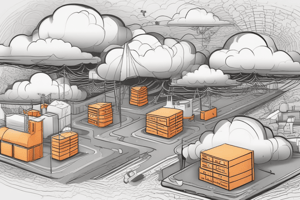Podcast
Questions and Answers
Which of the following is NOT a typical benefit associated with moving to AWS?
Which of the following is NOT a typical benefit associated with moving to AWS?
- Optimized costs
- Increased innovation
- Accelerated time to market
- Increased complexity and risk (correct)
AWS Regions are completely independent of each other.
AWS Regions are completely independent of each other.
True (A)
What is the primary purpose of AWS Local Zones?
What is the primary purpose of AWS Local Zones?
To deliver low-latency applications.
AWS uses a global network consisting of more than 400+ ______ to provide content delivery services.
AWS uses a global network consisting of more than 400+ ______ to provide content delivery services.
Match the following AWS infrastructure elements with their descriptions:
Match the following AWS infrastructure elements with their descriptions:
Which of the following best describes an AWS Region?
Which of the following best describes an AWS Region?
Edge locations are used to run virtual machines close to the end user.
Edge locations are used to run virtual machines close to the end user.
Name three factors that can influence the selection of an AWS Region.
Name three factors that can influence the selection of an AWS Region.
AWS ______ is a DNS web service that is highly available and scalable.
AWS ______ is a DNS web service that is highly available and scalable.
Match the Route 53 routing policies with their descriptions:
Match the Route 53 routing policies with their descriptions:
What is the purpose of Availability Zones in AWS?
What is the purpose of Availability Zones in AWS?
Data centers are organized into edge locations.
Data centers are organized into edge locations.
What AWS service can be used to provide a content delivery network?
What AWS service can be used to provide a content delivery network?
Using Amazon CloudFront can help to decrease ______ in accessing your content.
Using Amazon CloudFront can help to decrease ______ in accessing your content.
Match the following AWS services with their primary function:
Match the following AWS services with their primary function:
Which of these AWS infrastructure components would you use to provide low latency connections for gaming?
Which of these AWS infrastructure components would you use to provide low latency connections for gaming?
An AWS Region consists of a single Availability Zone.
An AWS Region consists of a single Availability Zone.
Which Route 53 routing policy allows you to route traffic based on the location of your users?
Which Route 53 routing policy allows you to route traffic based on the location of your users?
With CloudFront, you should choose your ______ first.
With CloudFront, you should choose your ______ first.
Match the following terms with their description:
Match the following terms with their description:
Which AWS service category includes tools for creating and managing databases?
Which AWS service category includes tools for creating and managing databases?
Route 53 can only resolve domain names to IP addresses; it cannot register or transfer domain names.
Route 53 can only resolve domain names to IP addresses; it cannot register or transfer domain names.
What type of routing policy would you use to send a percentage of your traffic to a new version of your application?
What type of routing policy would you use to send a percentage of your traffic to a new version of your application?
AWS ______ is used to protect your content, applications, and APIs against malicious bots, and DDoS attacks.
AWS ______ is used to protect your content, applications, and APIs against malicious bots, and DDoS attacks.
Match the following AWS service categories with their descriptions:
Match the following AWS service categories with their descriptions:
In Route 53, which routing policy would you use to direct users to different endpoints based on their location?
In Route 53, which routing policy would you use to direct users to different endpoints based on their location?
AWS Local Zones provide a fully consistent AWS experience, meaning all AWS services are available in every Local Zone.
AWS Local Zones provide a fully consistent AWS experience, meaning all AWS services are available in every Local Zone.
What is the primary benefit of using edge locations with Amazon CloudFront?
What is the primary benefit of using edge locations with Amazon CloudFront?
When configuring CloudFront, adding a custom domain name is ______.
When configuring CloudFront, adding a custom domain name is ______.
Match the following AWS services with the service category they belong to:
Match the following AWS services with the service category they belong to:
What is the main purpose of AWS WAF?
What is the main purpose of AWS WAF?
Edge locations only cache static content.
Edge locations only cache static content.
What is the default routing policy in Route 53?
What is the default routing policy in Route 53?
In CloudFront, a Time To Live (TTL) is a configuration that determines how long content stays in the ______.
In CloudFront, a Time To Live (TTL) is a configuration that determines how long content stays in the ______.
Match the following AWS components to their function in high availability setups:
Match the following AWS components to their function in high availability setups:
According to the image, which one is NOT a characteristic of AWS Global Infrastructure?
According to the image, which one is NOT a characteristic of AWS Global Infrastructure?
AWS services will not be available if the AWS Region goes down.
AWS services will not be available if the AWS Region goes down.
Why is important to choose a AWS Region near your clients? Give me two valid reasons.
Why is important to choose a AWS Region near your clients? Give me two valid reasons.
The most important feature to choose AWS Local Zone is ______.
The most important feature to choose AWS Local Zone is ______.
Match the services with the characteristics to the main service:
- Reduce latency.
- DNS highly available.
- Content Delivery Network.
Match the services with the characteristics to the main service:
- Reduce latency.
- DNS highly available.
- Content Delivery Network.
Flashcards
Benefits of AWS Services
Benefits of AWS Services
AWS services are hosted in global data centers, offering a secure and robust environment for business needs.
Why Move to AWS?
Why Move to AWS?
Agility, Optimize costs, Minimize security vulnerabilities, Reduce management complexity.
AWS Service Categories
AWS Service Categories
AWS services are categorized into Analytics, Compute, Database, Machine Learning, IoT and more.
AWS Global Infrastructure
AWS Global Infrastructure
Signup and view all the flashcards
AWS Data Centers
AWS Data Centers
Signup and view all the flashcards
Availability Zones (AZs)
Availability Zones (AZs)
Signup and view all the flashcards
Region Selection Factors
Region Selection Factors
Signup and view all the flashcards
AWS Local Zones
AWS Local Zones
Signup and view all the flashcards
Edge Locations
Edge Locations
Signup and view all the flashcards
Edge location features
Edge location features
Signup and view all the flashcards
Amazon Route 53
Amazon Route 53
Signup and view all the flashcards
Functionality of Route 53
Functionality of Route 53
Signup and view all the flashcards
Route 53: Routing policies
Route 53: Routing policies
Signup and view all the flashcards
Amazon CloudFront
Amazon CloudFront
Signup and view all the flashcards
Edge Caching Benefits
Edge Caching Benefits
Signup and view all the flashcards
Study Notes
- This module provides an overview of architecting on AWS
- It covers Amazon Web Services (AWS) services, AWS infrastructure, Route 53, and CloudFront
Amazon Web Services (AWS)
- AWS has global data centers
- AWS offers more than 200 services
- AWS services are secure and robust
- "Pay as you go" payment model
Why customers move to AWS
- To increase business agility
- To accelerate time to market
- Scale seamlessly
- Increase innovation
- To optimize costs
- To minimize security vulnerabilities
- To reduce management complexity and risk
AWS service categories
- Analytics
- Customer enablement
- Developer tools
- Customer engagement applications
- Business applications
- Application integration
- Migration and transfer
- End user computing
- Machine learning
- Networking and content delivery
- Security identity and compliance
- Management and governance
- Storage
- Containers
- Game development
- Satellite
- Front-end web and mobile
- Robotics
- VR and AR
- Internet of Things (IoT)
- Media services
- Blockchain
- Quantum technologies
AWS infrastructure
- AWS infrastructure is organized into: data centers, availability zones, regions, AWS local zones, and edge locations
AWS data centers
- AWS services operate within AWS data centers
- Data Centers host thousands of servers
- Each location uses AWS proprietary network equipment
- Data centers are organized into Availability Zones
Availability Zones
- Availability Zones contain data centers in a Region
- Availability Zones are designed for fault isolation and high availability
- Availability Zones are interconnected by using high-speed private links
AWS Regions
- Each Region is completely independent
- Each Region uses AWS network infrastructure
- Each Region has multiple Availability Zones
Factors that impact Region selection
- Governance
- Service availability
- Latency
- Cost
AWS Local Zones
- AWS Local Zones are used for media and entertainment content creation
- They are used for real-time gaming
- They are used for machine learning inference
- They are used for live video streaming
- They are used for augmented reality (AR) and virtual reality (VR)
Edge Locations
- Edge locations run in major cities around the world
- Edge locations support AWS services like Amazon Route 53 and Amazon CloudFront
AWS Local Zone and edge location features
- Local Zones: Low latency, local data processing, consistent AWS experience
- Edge locations: caching of data, fast delivery of content, better user experience
Amazon Route 53
- Route 53 resolves domain names to IP addresses
- Route 53 registers or transfers a domain name
- Route 53 routes requests based on latency, health checks, and other criteria
Route 53 public and private DNS
- Public hosted zones route to internet-facing resources and resolve from the internet
- Private hosted zones route to VPC resources and resolve from inside the VPC
Route 53 Routing policies
- Simple
- Failover
- Geolocation
- Geoproximity
- Latency-based
- Multivalue answer
- Weighted
Amazon CloudFront
- Amazon CloudFront is the service can provide the content delivery network that we need
- AWS uses a global network of 400+ points of presence
Amazon CloudFront overview
- Amazon CloudFront is a global content delivery network that integrates with AWS WAF and AWS Shield
- Amazon CloudFront handles static or dynamic content and has built-in security features
Edge caching
- Edge caching decreases latency by caching data at edge locations
- Edge caching increases security
CloudFront caching steps
- The request is routed to the optimal edge location
- Non-cached content is retrieved from the origin
- Original content is transferred to a CloudFront edge location for caching
- Data is transferred to the user
Configuring CloudFront
- Choose your origin such as: S3 bucket, ELB load balancer, custom origin, EC2 instance, on-premises server
- Create a distribution with a defined cache behavior with: path pattern, protocol policy, HTTP methods, signed URL, time to live (TTL), cache key settings
- Optionally, associate a function, associate AWS WAF web access control list (web ACL), add custom domain name
Improving performance
- AWS handles TCP optimization, TLS 1.3 support, and dynamic content placement
- You can: Choose your caching strategy, improve your cache hit ratio, and use CloudFront Origin Shield
Studying That Suits You
Use AI to generate personalized quizzes and flashcards to suit your learning preferences.




